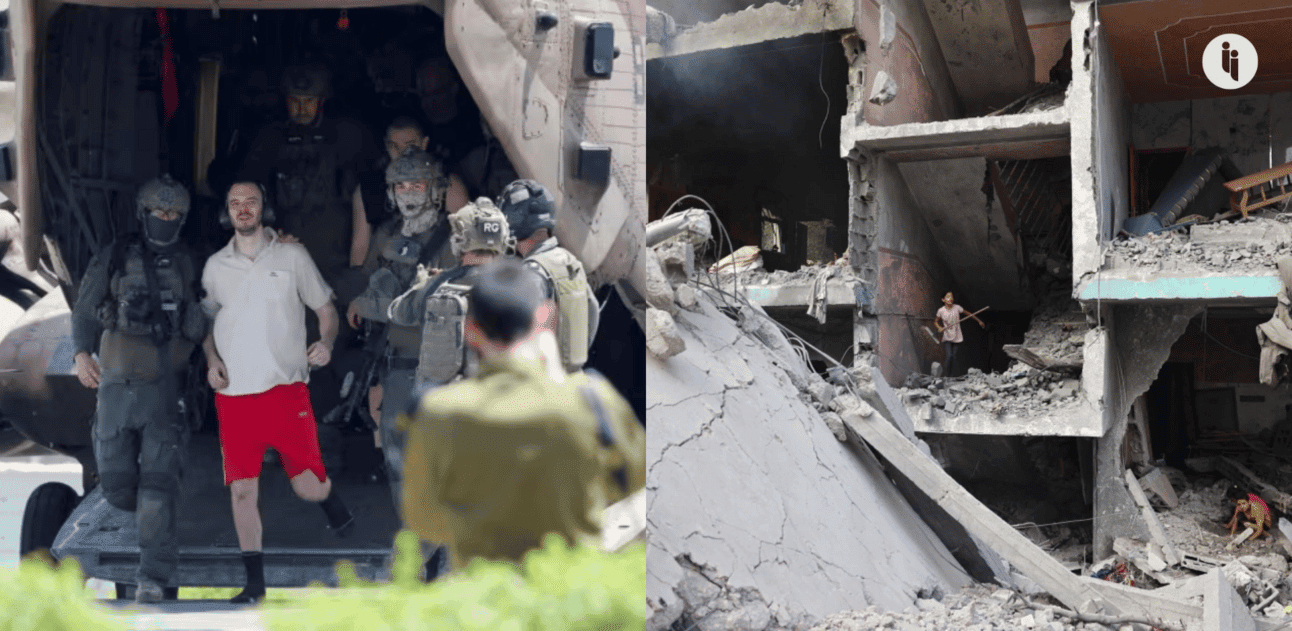Israel rescued four hostages in a Gaza raid over the weekend. We’ve pieced together what happened, and why it matters.
Israel received intelligence on the location of the hostages last month. Some of it reportedly came from the US, including imagery and signals intelligence.
Either way, it pinpointed the hostages in Nuseirat, a part of central Gaza designated a refugee camp after the 1948 Arab-Israeli war. It’s now a densely populated concrete urban area, with tents also housing displaced families from elsewhere in Gaza.
Stay on top of your world from inside your inbox.
Subscribe for free today and receive way much more insights.
Trusted by 91,000+ subscribers
No spam. No noise. Unsubscribe any time.
So over several weeks, Israel rehearsed a rescue operation using life-sized replicas of the two apartment buildings where Hamas was holding the hostages.
And then, at 11am on Saturday, a vehicle piled with mattresses and other household items arrived in Nuseirat. Inside were Israeli forces – fluent in Arabic – disguised as a displaced family from southern Gaza. Their plan was a daytime raid to maximise surprise – but that also meant the streets were busy.
The Israelis reportedly told onlookers they were renting an apartment inside – they then entered, killed several Hamas guards, rescued a hostage in a locked room, and exfiltrated her to a helicopter staging at a beach nearby.
Simultaneously, a second Israeli unit used a ladder to enter an apartment 200m away. Reports emerged that it belonged to Abdallah Aljamal, who wrote for local media. (He’s also listed as an Al Jazeera writer, though the Qatar-owned outlet says this was because he penned one opinion piece in 2019.)
When the Israelis entered, a gunfight broke out killing both Aljamal and his father (a local doctor) – one of the Israelis was hit and later died.
The Israelis then rescued the three hostages locked inside and bundled them into a vehicle. At this point, Israel says Hamas attacked the vehicle with rocket-propelled grenades, and the Israelis took cover and called for air support.
Israeli helicopters and drones then opened fire. Graphic footage and witness reports indicate this led to a high death toll in the streets and nearby buildings: Hamas says 274 were killed and 698 injured, while Israel says “fewer than 100” died. Neither source has distinguished between combatants and others.
This second Israeli unit eventually got the three hostages to the evacuation beach, near the US-built humanitarian pier (Israel and the US have rejected claims that Israel used the pier or any aid trucks for the operation).
The whole event, from first shots fired to the final helicopter lifting off, lasted around an hour and a half. And that’s the clearest we can get around what happened. From there, as you can imagine, claims diverge dramatically.
In Israel, folks greeted the rescue with jubilation, bringing the total number of hostages returned via force to seven, across three operations (Hamas released another 100 hostages during November’s brief truce).
As for civilian deaths, Israel blames Hamas, which kidnapped Israeli civilians, hid them among Palestinian civilians, and refused to return them. Israel also blames Hamas for opening fire on the Israelis escaping through a crowded street.
For its part, Hamas has described the events as “brutal and barbaric”, while claiming three other hostages also died (claims Israel rejects).
INTRIGUE’S TAKE
So zooming out a little, what does all this mean?
- Hamas still holds ~120 hostages (a third of whom are presumed dead) and will now inevitably take measures to prevent similar raids, while hardening its own negotiating position (the group said “your captives won’t be released unless our prisoners are freed“).
- Israel is celebrating what one opposition figure described as “a great light in the terrible darkness”, though its own military concedes it can’t release all remaining 120 hostages the same way – one way or another, that’ll embolden Netanyahu, not push him back to negotiate.
- And Netanyahu’s unity government has now split, with minister Benny Gantz exiting overnight. Plus, critics have noted Netanyahu’s availability for Shabbat-breaching photo ops with the rescued hostages, but not to meet the many angry families still awaiting news. Still, we don’t see this dislodging him from power any time soon.
So to answer our own question – what does this latest development mean? In a geopolitical sense, not a lot. We continue to see more of the same ahead.
Also worth noting:
- Netanyahu drew comparisons with the Entebbe raid of 1976, when Israeli commandos rescued 102 hostages being held by Palestinian and German hijackers on a tarmac in Uganda. Netanyahu’s older brother died in that raid, which inspired a dozen subsequent films.
- Israel’s Western partners – like the US, France, and Germany – have welcomed the release of the hostages. Others – like Egypt, Lebanon, and Kuwait – have condemned the high human cost involved.







